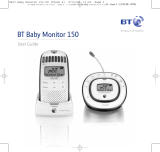
20
7.3.2 Activating Eco Max mode
1 Select ‘Eco Max’ in the menu with the + and -
buttons and press OK to conrm.
2 When the display shows ‘Turn On’, press OK
to switch on the Eco Max mode.
3 The warning message ‘!No alert if out of
range, OK?’ appears on the display. Press OK
to conrm.
D
Note:
The warning message scrolls across the display
twice. If you do not press OK, the parent
unit leaves the menu and the Eco Max mode
remains off.
• The Eco Max indication ashes on the
display. The ‘link’ light ashes green slowly.
• When the parent unit receives a signal from
the baby unit because the baby makes a
sound, the ‘link’ light turns solid green again.
7.3.3 Deactivating Eco Max mode
1 Press the MENU button
2 Use the + and - buttons to select ‘Eco Max’
and press OK to conrm.
3 Use the + and - buttons to select ‘Turn Off’
and press OK to conrm.
7.3 Eco Max mode
This baby monitor has Smart Eco that
automatically reduces the DECT signal from the
baby unit as the distance between parent unit
and baby unit becomes shorter. By reducing radio
transmission, it helps to save energy.
If you want to save even more energy and to stop
radio transmission, activate the Eco Max mode
in the menu of the parent unit. In this mode, the
DECT signal of the baby unit is switched off. As
soon as the baby makes a sound, the DECT signal
of the baby unit automatically switches on again.
C
Caution:
In Eco Max mode, the parent unit receives
feedback from the baby unit with a delay. When
yourbabymakesasound,thebabyunitrsthas
to reactivate radio transmission before it can
send feedback to the parent unit.
7.3.1 Please note the following:
• Before you select the Eco Max mode in the
menu of the parent unit, make sure that the
parent unit and baby unit are within operating
range, see section ‘Operating range’ in chapter
‘Using the baby monitor’. In Eco Max mode
you do not receive feedback when the parent
unit is out of range of the baby unit. You can
check the link by pressing any button on the
parent unit.
• If there is no radio transmission from the baby
unit to the parent unit in Eco Max mode, the
sound level lights are off. The sound level lights
go on when the baby unit reactivates radio
transmission because the baby makes a sound
above the selected sensitivity level.
• If you want to operate the baby monitor in
Eco Max mode, make sure the microphone
sensitivity is set between level 1 and level 3.
If the microphone sensitivity is set at level
4, the baby unit does not switch off radio
transmission in Eco Max mode.

























